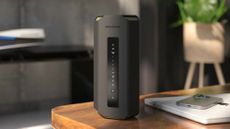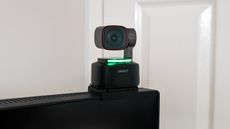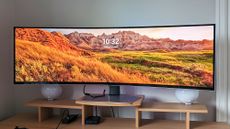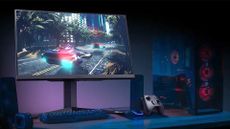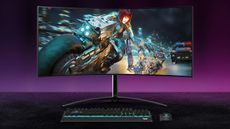The HyperX Armada 27 is one of the first monitors from the company better known for its peripherals – and looking at the design and the specs list we have in front of us with this piece of hardware, it has a strong claim to being one of the best gaming monitors around.
You'll notice that it comes with a monitor arm rather than a conventional stand, which may be the key reason you decide to pick this piece of hardware over another more conventional monitor. It also boasts some impressive specs in terms of its screen, which we'll get into in our review below.
If you're looking to kit out the rest of your gaming setup then we've got lots more buying advice for you: have a look at our guides to the best gaming chairs, the best gaming keyboards, and the best gaming headsets to see if there are other upgrades worth getting.
HyperX Armada 27: price and availability
The widgets included on this page should lead you to the best prices for the HyperX Armada 27 on the web, but at the time of writing you can pick the monitor up for around £500 in the UK and $500 in the US. If you're shopping in the UK, you can get the monitor from retailers such as Game, as well as from HyperX itself.
HyperX Armada 27 review: design and setup
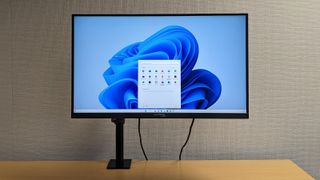
The HyperX Armada 27 takes some setting up, coming in three main pieces: a stand that clamps to your desk (unusual in a gaming monitor); an arm that connects to the stand; and the monitor itself that clips into the arm. It's a somewhat unusual setup, but it does give you a great degree of fluidity in terms of the way that the HyperX Armada 27 can be moved and positioned around your desk.
You're able to change the height, the horizontal and vertical angle, and the rotation of the monitor on its arm – you can even push it out of the way if you're working on a laptop or doing something else. Another benefit is that there's no room taken up on your desk really, so even if the setup is a bit unconventional, there are definitely a few good reasons to choose it. Thanks to the VESA mount option, you can put this up on a wall or even attach it to a different monitor arm if you prefer.
As far as the aesthetic styling of the HyperX Armada 27 goes, it's clearly attempting a sleek and minimal look. There are hardly any flourishes to speak of – no lighting on the back, for example, and only subtle HyperX branding on the front and back. You can actually connect two of these screens to the same base clamp, if you want, though clearly you're going to have to pay double the price for that sort of setup.
When it comes to connectivity, you're limited to two HDMI 2.0 ports and one DisplayPort 1.4 port – that'll be enough for many people, but the latest HDMI 2.1 standard is missing, and you don't get anything in the way of USB connectivity or a USB hub, which monitors at this price often come with. There are no integrated speakers of any kind either. The on-screen menus, which are comprehensive, are controlled with a small joystick around the back of the monitor on the right-hand side.
HyperX Armada 27 review: features and picture
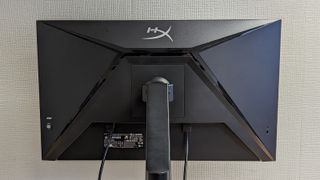
There are some very appealing specs attached to the HyperX Armada 27, like the 165Hz refresh rate, the 1ms grey-to-grey response time, the 400-nits of maximum brightness, and the 1,000:1 contrast ratio. You've also got support for HDR10 and DisplayHDR 400 built-in, as well as Nvidia G-Sync, and a 95 per cent coverage of the DCI-P3 colour space. The IPS LCD screen itself measures 27-inches from corner to corner, and has a native resolution of 2560 x 1440 pixels across its 16:9 aspect ratio.
All that adds up to a picture that's sharp, bright and vivid, with an excellent level of fluidity when it comes to fast-moving games and videos. We did some movie-watching and some game-playing on the HyperX Armada 27, as well as a bit of general computing, and it's certainly easy on the eye. The only slight disappointment is the lack of truly deep backs, but that's still a common drawback for any non-OLED screen.
The on-screen menu is reasonably easy to navigate around, and you get a decent selection of picture modes to switch between if you want to change the balance of colours, motion, and other options – though we found the default, out-of-the-box configuration perfectly acceptable. HDR performance is good without being amazing, largely given the black level performance, and overall we were very happy with the picture produced by the HyperX Armada 27.
There are no integrated speakers on this monitor which is a shame, and no headphone jack either, so you're going to be relying on the device that you've plugged the HyperX Armada 27 into for your audio. Even if the speakers aren't of the best quality, we usually prefer to see them included, so you've got the option. There's some simple cable management on the back of the monitor arm which is good to see, and a bright red HyperX-branded HDMI cable in the box (probably the most colourful part of this kit).
HyperX Armada 27 review: verdict
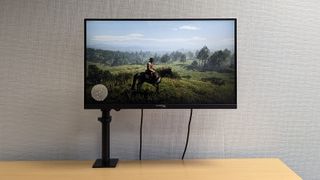
As a 27-inch 1440p monitor the HyperX Armada 27 is up against a lot of similar competitors with similar specifications. It's not easy trying to pick through the different models on offer, and your choice may well simply come down to price. This particular model is slightly on the expensive side, especially given the relatively limited number of port options and no integrated speakers.
On the whole, however, the picture quality here – which is what's most important, after all – looks great in a variety of different use cases. You're most likely to be using this as a gaming monitor, and we found that games looked really bright and smooth at this size and resolution.
But it's the monitor arm aspect of the HyperX Armada 27 that's likely to be the biggest reason you want this particular monitor – it's an unusual feature for monitors of this type and size, and adds certain practicalities for desk space. That's what'll give it a thumbs up for many prospective buyers.
Also consider
You've got a lot of options at this 27-inch size: take the Sony Inzone M9 for example, which keeps the same panel size but ups the resolution to 4K. It's much more expensive, but you do get more ports to make use of, and you do get the HDMI 2.1 upgrade that's likely to make the monitor more appealing to those planning to attach a PlayStation 5 or Xbox Series X.
Then there's something like the 27-inch Monoprice Dark Matter, which comes in at a lower price than the HyperX, but also has a lower resolution. However, it does offer a better refresh rate at 240Hz. It supports the AMD FreeSync Premium tech rather than the Nvidia G-Sync alternative, which is a reminder that you also need to consider the PC (or console) that you're hooking up to the monitor.





